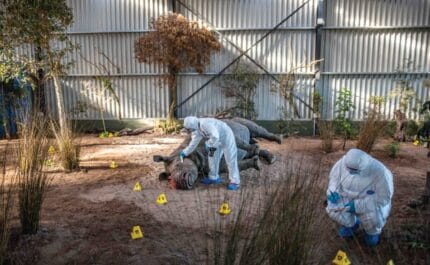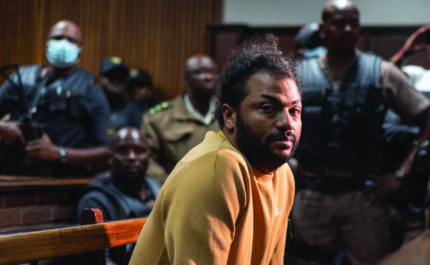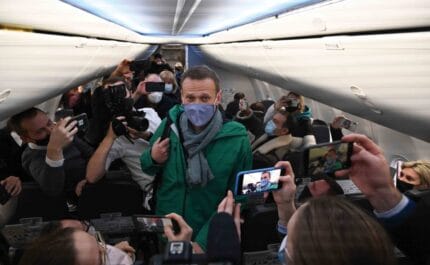“Derna is a city drowning in sorrow”
In the early hours of 11th September Libya experienced one of the most severe disasters in its history when flood waters surged through the city of Derna, killing thousands of people. Photographer Mohamed Nabil, who lives in the city, describes what he witnessed and how Derna has responded in the aftermath of the tragedy
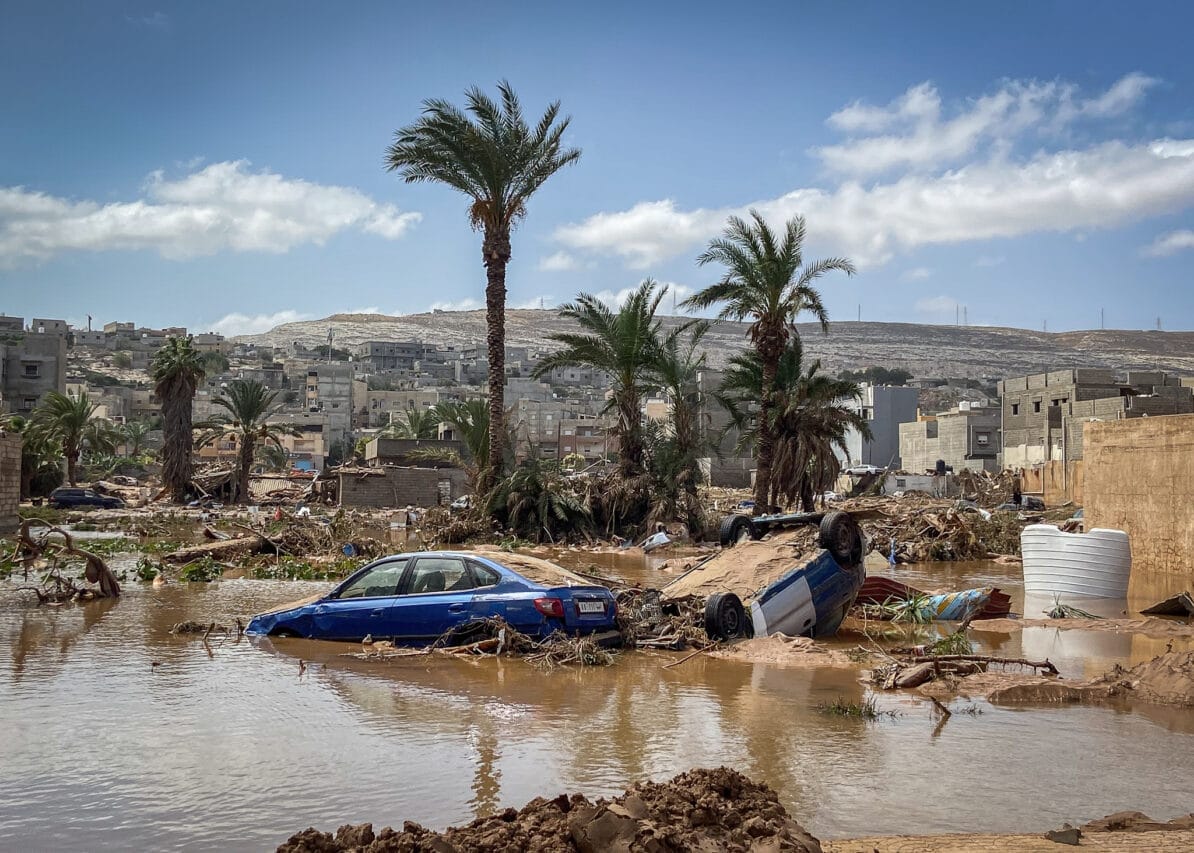
11th September 2023 (Taken from: #52)
The heavy rains brought by Storm Daniel started to fall on Derna on 10th September. Within hours photographer Mohamed Nabil, who lives in the Libyan port city, knew that he was witnessing something unprecedented. “I realised that the storm would be catastrophic when I saw the valley, which runs through the heart of the city, becoming inundated with water,” he says. “The force of the water’s flow was daunting and powerful. It was ruthless.”
At approximately 2.30am on 11th September, after hours of torrential rain, two dams above the city collapsed and the waters they were holding back swept through Derna. Having documented the storm until 1am, Nabil was at his home at the top of the valley trying to manage the water seeping through his windows and under his doors at the time disaster struck. “At around 3.30am, I started to hear people’s desperate cries and screams,” he says. “Around 4am, I went out onto the streets and was met with the shocking reality that the city had been devastated: the heart of Derna, al-Wadi Street, had been turned into a sea of debris… The once prominent buildings, wide streets, large structures and beautiful nature that defined the valley had all vanished. The city’s familiar features turned unrecognisable. Water levels had reached high storeys. What I saw reminded me of how doomsday is described in the Qur’an.”
The scale of the damage was almost beyond comprehension. As much as a quarter of the city was destroyed, with entire neighbourhoods swept into the sea. Two months later there is still no official confirmation of the number of victims, with estimates as high as 4,300 dead and a further 8,500 missing in a city that was formerly home to 90,000 residents. The cities of Benghazi, Sousa and Al-Marj were also badly affected by the disaster.

A survivor walks the streets of Derna shortly after the floods. Photo: Mohamed Nabil
“Words fail to capture the scenes on that dreadful night,” says Nabil. “Parents grieved for their children; children mourned the loss of their parents. At some point, I stopped asking people about the fate of their families and loved ones. Their answer had become tragically common: ‘They were all swept away by the floods’.” With mobile phone reception and internet connection down, communication was difficult, adding to the fear of those looking for lost loved ones.
As the sun rose the scale of the disaster became even more apparent. “I captured this photo [at the top of this story] at around 7am,” says Nabil. “We were actively searching for the bodies of the deceased. I took this photo to document the magnitude of the disaster and how it destroyed everything around. In this specific location, there was a building that had completely vanished. It was truly bizarre to realise that the whole structure had just been swept away.”
Libya, which has vast oil reserves, has been plagued by conflict and division since the fall of long-time strongman leader Muammar Gaddafi in 2011, with national elections repeatedly delayed. A UN-backed government rules over the west of the country, while the east, where Derna is located, has its own government backed by forces loyal to military leader General Khalifa Haftar. In the first hours after the disaster Nabil saw little visible presence from either administration.
“I have limited insight into the specific role that authorities played in the rescue operation,” the photographer says. “What I personally witnessed, and [what] dominated the rescue scene, were the acts of Libyan families, coming from both the eastern and western sides of the country, rushing to Derna to support the city and its people. There was a genuine spirit of fraternity. They came to stand beside their brothers and sisters during this critical time.”
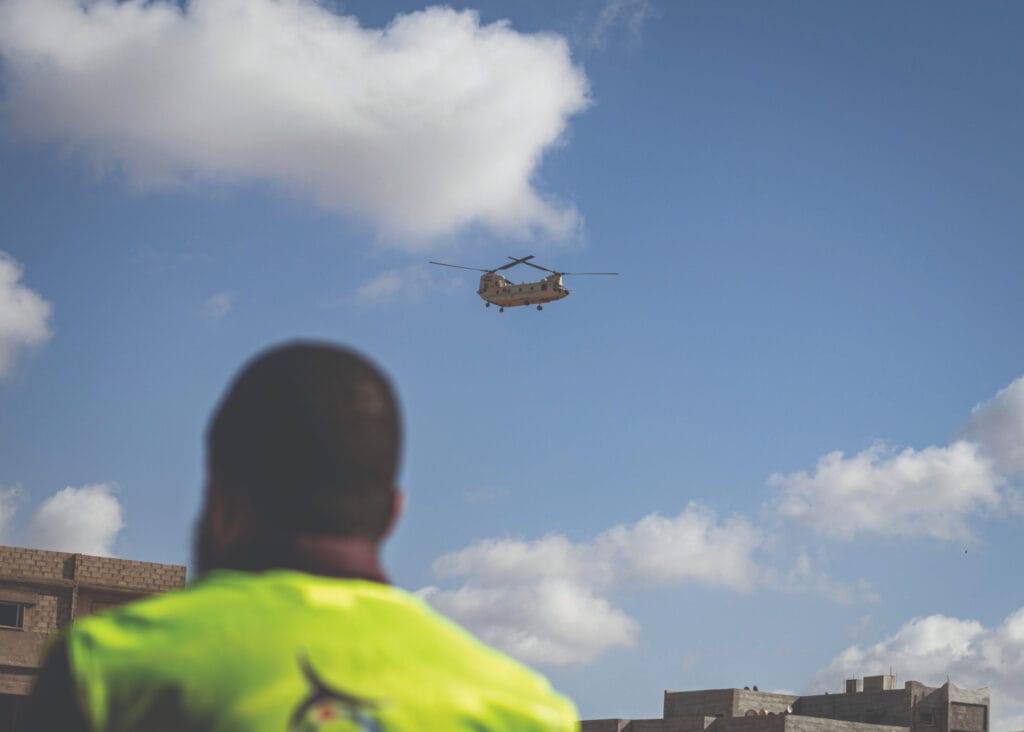
Aid arrives in the city on 14th September. Photo: Mohamed Nabil
Nabil joined in the rescue efforts. “The Red Crescent was highly organised and ready from the very first moments,” he says. “They lost some of their members and the building they had been operating from [in the flood], but they showed extraordinary efforts on the ground.” These efforts were supported by locals. “In the immediate aftermath, [the] communal solidarity was so heartwarming,” says Nabil. “People generously opened their homes to shelter families struck by the floods. People offered their clothing, food and any forms of aid they could afford to support all those in need.”

A Red Crescent ambulance transports victims of the flood, 14th September. Photo: Mohamed Nabil
As hopes of rescuing more survivors faded, a grim task began. “A dedicated committee was formed to capture photographs [and DNA samples] of bodies,” says Nabil of the efforts to identify the thousands of corpses in the city. “So that at a later stage, the relevant authorities would be able to issue death certificates and the victims would finally rest in peace.”
Having helped with the rescue effort, Nabil began to document what was left of Derna. “The city was always well-known for its culture, art and education,” he says. “It played a significant role in the development of Libya, with major contributions on political, cultural and educational levels. Derna was a place of beauty.” His photographs, he says, “show the loss of our beloved city we once knew.”
“When I shared my photographs, it was my intention to capture the suffering and make it resonate with those who could extend a helping hand to our city,” he says. “Documenting it is crucial to motivating people to advocate for an international and independent investigation into the disaster’s root causes.”

Volunteers and rescue workers travelled from across the country to help in the immediate aftermath of the disaster. Photo: Mohamed Nabil
Nabil believes there were two primary factors behind the tragedy. “First, the storm itself was extraordinarily powerful and destructive,” he says. “The second, and arguably more significant factor for the severity of the disaster, lies in the authorities’ negligence in maintaining and renovating the exhausted dams. The dams had been overlooked for far too long and their deterioration had reached a very fragile point.”
Engineers had issued warnings about the urgent need to strengthen the dams’ defences as recently as last year, when a report concluded that heavy rainfall would be “likely to cause one of the two dams to collapse, making the residents of the valley and the city of Derna vulnerable due to a high risk of flooding.” Both dams were built in the 1970s. The larger of the two, Abu Mansour, located eight miles from the city, was over 240 feet high and could hold up to 22.5 million cubic metres of water. The smaller, known as Belad, was built on the outskirts of Derna and could hold 1.5 million cubic metres of water. On the night of the 11th it seems that Abu Mansour collapsed under the weight of the water, causing a surge which destroyed Belad. The combined waters then swept into Derna. According to a 2021 report by a state-run audit agency, more than $2 million had been allocated for maintenance of the dams in 2012, but no work was carried out.
Within days Libya’s general prosecutor, Al-Sediq al-Sour, announced an inquiry into the collapse of the two dams and into the allocation of maintenance funds, but the declaration did little to quell the rising anger in Derna. On 18th September, a week after the disaster, protests broke out across the city. “People gathered at the square of al-Sahaba mosque, situated at the heart of the city,” says Nabil. “I didn’t participate in the protest; instead, I captured these photos to reflect the frustration and rage of the people. This place holds deep symbolism for Derna, which is why people chose to gather there and express their anger, grief and unity. I felt a glimmer of hope hearing chants of ‘Neither east nor west, Libya is [united]’. I couldn’t have imagined that we would all come together to express collective emotions of anger and hope for change and accountability.”
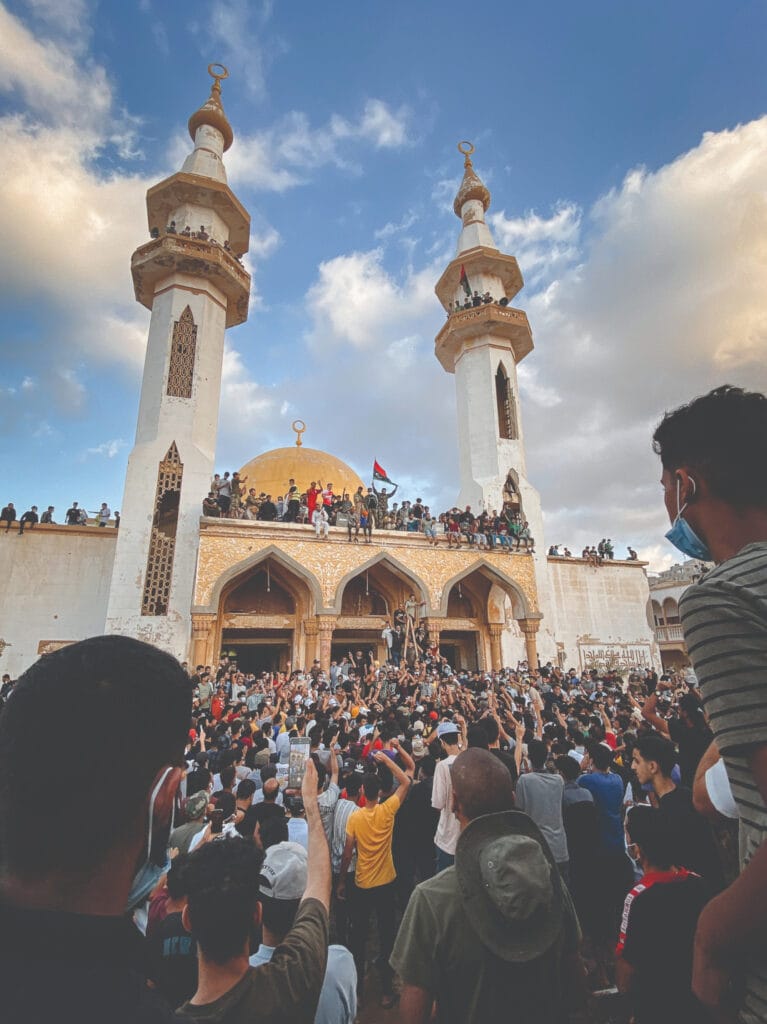
Protesters gather at al-Sahaba mosque, 18th September. Photo: Mohamed Nabil
This solidarity was also expressed in graffiti that began to appear across the city, with Nabil seeing one phrase sprayed repeatedly. “‘Libya Waheda’ means ‘One Libya’,” he says. “There is only one Libyan nation. Over the past 14 years, Libya has been going through wars and political conflicts between the east and the west, as well as among different communities. In the wake of this disaster, all sides have come together. This graffiti describes what happened after the flood – Libya became united. I met people from all Libyan cities, even places that I had not previously known or visited. I met people who were determined to support the people of Derna, to revive the city and bring it back to life.”
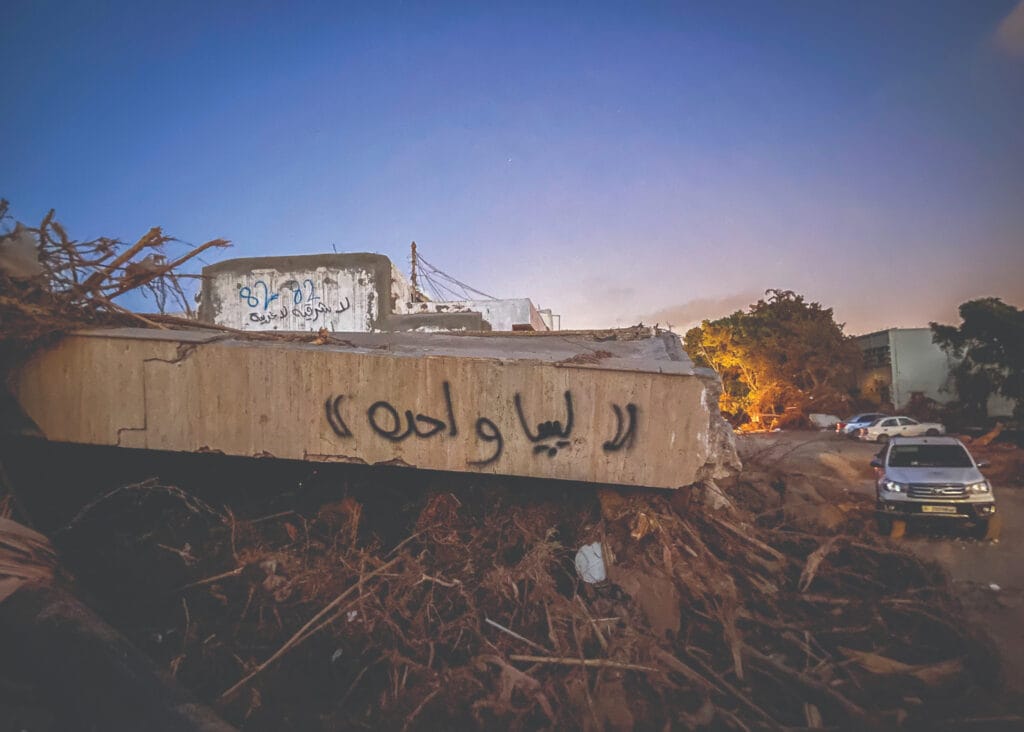
Graffiti proclaiming ‘Libya Waheda’ (‘One Libya’) on a destroyed building. Photo: Mohamed Nabil
At a national level there is little sign of unity, however, with the country’s competing administrations at odds about how to rebuild Derna. “The process remains largely vague,” says Nabil. “It has been announced that 12 billion Libyan dinars [$2.5bn] have been allocated to rebuild the city, but we still have not witnessed tangible progress on the ground. In Libya, there is a tendency for a lot of talking, back and forth, without transforming the talk into real action.” In October the administration in eastern Libya postponed a reconstruction conference with the UN, raising concerns about how donations will be spent and over the lack of coordination with its rivals in the west of the country.
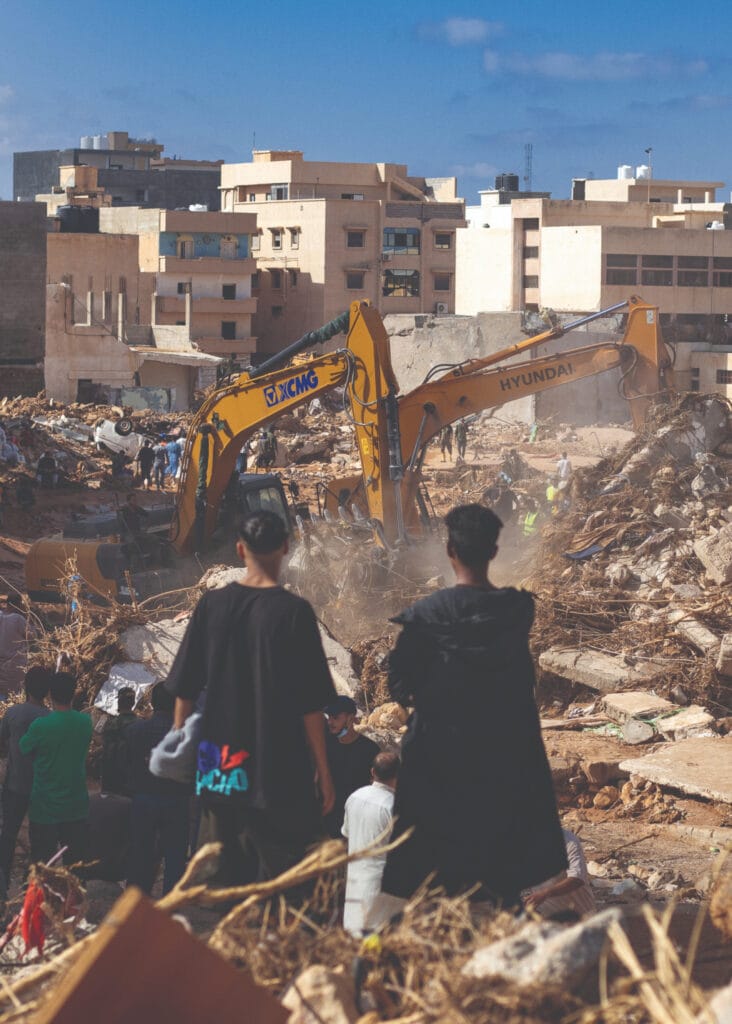
Machinery clears rubble from destroyed buildings. Photo: Mohamed Nabil
Two months after the disaster it is difficult to get a clear picture of the rebuilding work that has taken place. During the September protests, foreign journalists were banned from entering the city after the authorities declared it unsafe, and checkpoints still remain in place. Meanwhile some moves have been made to hold people accountable for the disaster. On 25th September the public prosecutor’s office announced that it had arrested 12 local officials in connection with the flood, including the former head of the water resources authority and the mayor of Derna, whose home was destroyed during protests.

A resident of al-Baher Street (Sea Street) surveys the damage to his home a week after the disaster. Photo: Mohamed Nabil
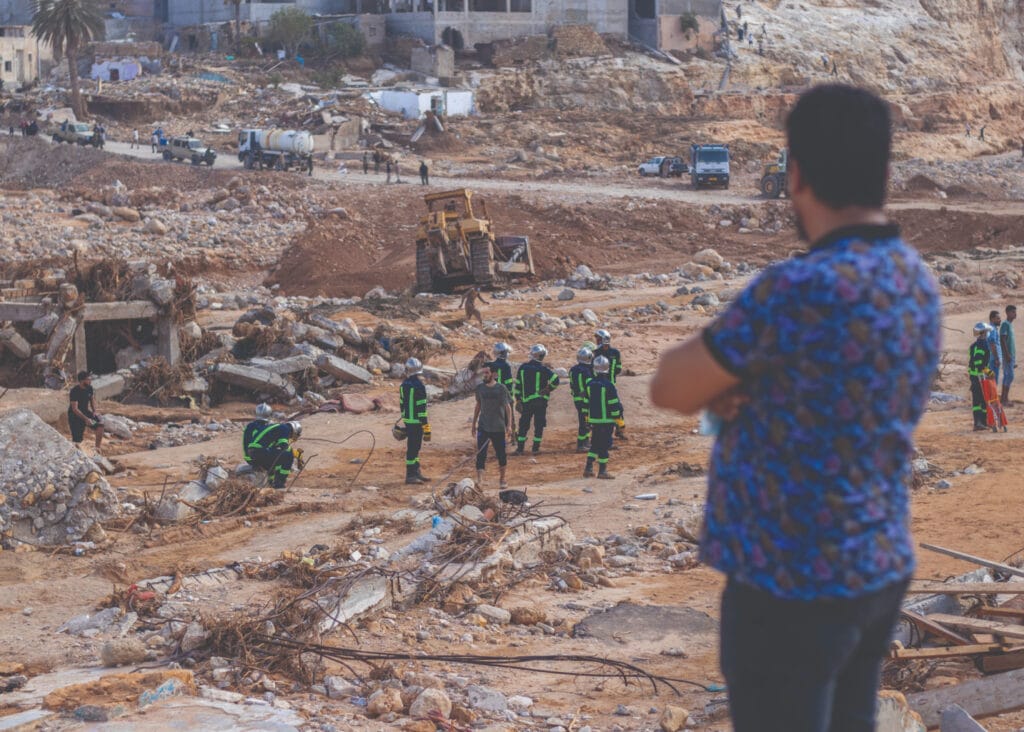
Despite the Tripoli-based government pledging $2.5bn to rebuild Derna and Benghazi, two months after the disaster Nabil and other residents are yet to witness much tangible progress. Photo: Mohamed Nabil
Nabil continues to document daily life. “Derna today is a city drowning in sorrow,” he says. “The people are starting, just now, to wake up from the impact of the trauma that befell them.” He hopes his images will help keep Derna’s plight on the international agenda. “Too often, people tend to forget about the communities affected by disasters, who after a period of time are left alone to deal with the aftermath,” he says. “I am determined to keep Derna and its resilient people in the spotlight. We are not mere numbers; we are individuals with unique stories, and we have endured one of the most horrific disasters in our history.” As for hopes that the ‘Libya Waheda’ spirit will translate into action through the holding of long-delayed elections and the creation of a unity government, Nabil is unsure. “I don’t have a definitive answer,” he says. “If I were to say ‘yes’, some might say I’m delusional. But I hope so.”
Mohamed Nabil’s photographs were originally published by the independent, non-profit news organisation The New Humanitarian. We would like to thank them for connecting us with Nabil in order to write this story
Slow Journalism in your inbox, plus infographics, offers and more: sign up for the free DG newsletter. Sign me up
Thanks for signing up.
